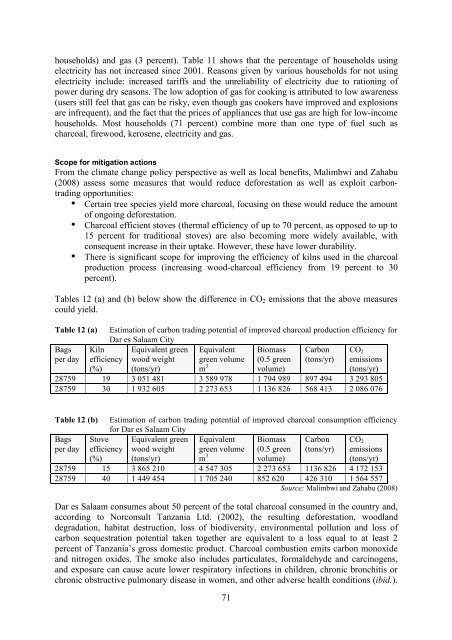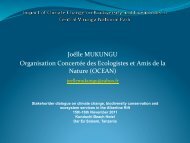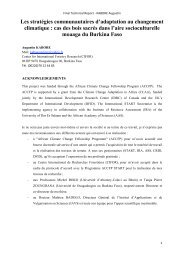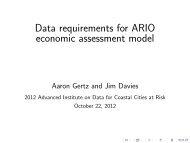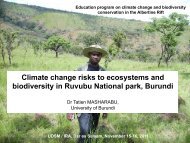Urban Poverty & Climate Change in Dar es Salaam, Tanzania:
Urban Poverty & Climate Change in Dar es Salaam, Tanzania:
Urban Poverty & Climate Change in Dar es Salaam, Tanzania:
Create successful ePaper yourself
Turn your PDF publications into a flip-book with our unique Google optimized e-Paper software.
households) and gas (3 percent). Table 11 shows that the percentage of households us<strong>in</strong>g<br />
electricity has not <strong>in</strong>creased s<strong>in</strong>ce 2001. Reasons given by various households for not us<strong>in</strong>g<br />
electricity <strong>in</strong>clude: <strong>in</strong>creased tariffs and the unreliability of electricity due to ration<strong>in</strong>g of<br />
power dur<strong>in</strong>g dry seasons. The low adoption of gas for cook<strong>in</strong>g is attributed to low awaren<strong>es</strong>s<br />
(users still feel that gas can be risky, even though gas cookers have improved and explosions<br />
are <strong>in</strong>frequent), and the fact that the pric<strong>es</strong> of applianc<strong>es</strong> that use gas are high for low-<strong>in</strong>come<br />
households. Most households (71 percent) comb<strong>in</strong>e more than one type of fuel such as<br />
charcoal, firewood, kerosene, electricity and gas.<br />
Scope for mitigation actions<br />
From the climate change policy perspective as well as local benefits, Malimbwi and Zahabu<br />
(2008) ass<strong>es</strong>s some measur<strong>es</strong> that would reduce defor<strong>es</strong>tation as well as exploit carbontrad<strong>in</strong>g<br />
opportuniti<strong>es</strong>:<br />
• Certa<strong>in</strong> tree speci<strong>es</strong> yield more charcoal, focus<strong>in</strong>g on th<strong>es</strong>e would reduce the amount<br />
of ongo<strong>in</strong>g defor<strong>es</strong>tation.<br />
• Charcoal efficient stov<strong>es</strong> (thermal efficiency of up to 70 percent, as opposed to up to<br />
15 percent for traditional stov<strong>es</strong>) are also becom<strong>in</strong>g more widely available, with<br />
consequent <strong>in</strong>crease <strong>in</strong> their uptake. However, th<strong>es</strong>e have lower durability.<br />
• There is significant scope for improv<strong>in</strong>g the efficiency of kilns used <strong>in</strong> the charcoal<br />
production proc<strong>es</strong>s (<strong>in</strong>creas<strong>in</strong>g wood-charcoal efficiency from 19 percent to 30<br />
percent).<br />
Tabl<strong>es</strong> 12 (a) and (b) below show the difference <strong>in</strong> CO2 emissions that the above measur<strong>es</strong><br />
could yield.<br />
Table 12 (a) Estimation of carbon trad<strong>in</strong>g potential of improved charcoal production efficiency for<br />
<strong>Dar</strong> <strong>es</strong> <strong>Salaam</strong> City<br />
Bags Kiln Equivalent green Equivalent<br />
per day efficiency wood weight green volume<br />
(%) (tons/yr) m 3<br />
Biomass Carbon CO2<br />
(0.5 green (tons/yr) emissions<br />
volume)<br />
(tons/yr)<br />
28759 19 3 051 481 3 589 978 1 794 989 897 494 3 293 805<br />
28759 30 1 932 605 2 273 653 1 136 826 568 413 2 086 076<br />
Table 12 (b) Estimation of carbon trad<strong>in</strong>g potential of improved charcoal consumption efficiency<br />
for <strong>Dar</strong> <strong>es</strong> <strong>Salaam</strong> City<br />
Bags Stove Equivalent green Equivalent<br />
per day efficiency wood weight green volume<br />
(%) (tons/yr) m 3<br />
Biomass Carbon CO2<br />
(0.5 green (tons/yr) emissions<br />
volume)<br />
(tons/yr)<br />
28759 15 3 865 210 4 547 305 2 273 653 1136 826 4 172 153<br />
28759 40 1 449 454 1 705 240 852 620 426 310 1 564 557<br />
Source: Malimbwi and Zahabu (2008)<br />
<strong>Dar</strong> <strong>es</strong> <strong>Salaam</strong> consum<strong>es</strong> about 50 percent of the total charcoal consumed <strong>in</strong> the country and,<br />
accord<strong>in</strong>g to Norconsult <strong>Tanzania</strong> Ltd. (2002), the r<strong>es</strong>ult<strong>in</strong>g defor<strong>es</strong>tation, woodland<br />
degradation, habitat d<strong>es</strong>truction, loss of biodiversity, environmental pollution and loss of<br />
carbon sequ<strong>es</strong>tration potential taken together are equivalent to a loss equal to at least 2<br />
percent of <strong>Tanzania</strong>’s gross dom<strong>es</strong>tic product. Charcoal combustion emits carbon monoxide<br />
and nitrogen oxid<strong>es</strong>. The smoke also <strong>in</strong>clud<strong>es</strong> particulat<strong>es</strong>, formaldehyde and carc<strong>in</strong>ogens,<br />
and exposure can cause acute lower r<strong>es</strong>piratory <strong>in</strong>fections <strong>in</strong> children, chronic bronchitis or<br />
chronic obstructive pulmonary disease <strong>in</strong> women, and other adverse health conditions (ibid.).<br />
71


